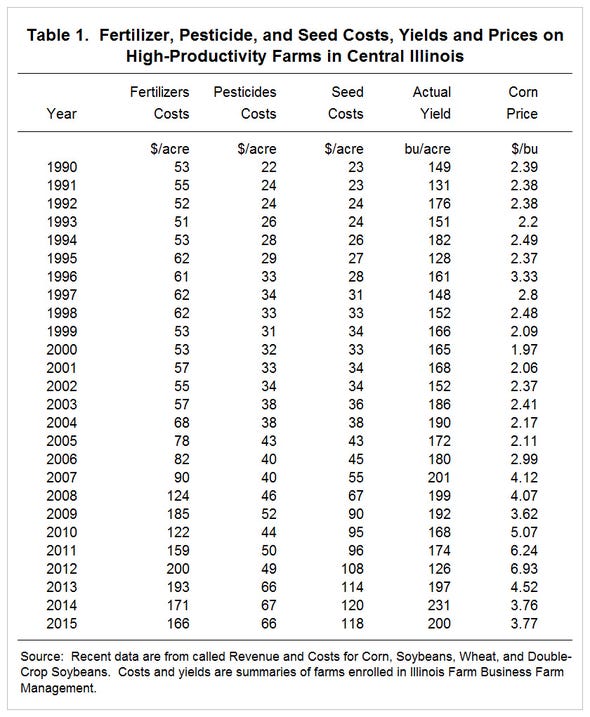July 13, 2016

Growth rates of fertilizer, pesticide, and seed costs have been higher in years following 2006 than they were between 1990 and 2006.
In 2015, the sum of fertilizer, pesticide, and seed costs were 48 percent of crop revenue, much higher than the 36 percent average from 1990 to 2006. These costs need to decrease, particularly if corn prices remain below $4. Otherwise, it will be difficult for revenues to be less than total costs.
Data Presented in Analysis
Figures below show fertilizer, pesticides, and seed costs for corn grown on high-productivity farmland in central Illinois. Data in these graphs are shown in Table 1. The first three columns give per acre fertilizer, pesticide, and seed costs. In addition, two other variables are used in figure presentations:
Actual corn yield
Corn price - average price received by farmers for corn grown in the particular year

Costs will be stated three ways: 1) costs per acre, 2) costs per bushel (cost per acre divided by yield), and costs as a percent of crop revenue (cost per acre divided by yield times corn price).
Data in Table 1 for recent years are presented in a publication called Revenue and Costs for Corn, Soybeans, Wheat, and Double-Crop Soybeans, which are summarized from farms enrolled in Illinois Farm Business Farm Management. Until recently this data was only compiled back to 2000. Work by the second author of this article during a James Scholar project extended this data back to 1990.
Per Acre Costs
Figure 1 shows per acre fertilizer, pesticide, and seed costs from 1990 to 2015. Note that there are two distinct periods: 1) Before 2006 and 2) after 2006. Between 1990 and 2006, costs grew at an average annual rate of 2.6 percent for fertilizer costs, 3.5 percent for pesticide costs, and 4 percent for seed costs. Growth rates were much higher from 2006 to 2015. Between 2006 and 2015, growth rates averaged 8.1percent for fertilizer, 5.7 percent for pesticides, and 11.3 percent for seed.

'Since 2006, seed has been the category with the highest increase. Before 2006, pesticides and seed were about the same magnitude. Because the 11.3 percent growth rate for seed costs was much higher than the 5.7 percent growth rate for pesticides, seed costs now are much larger than pesticide costs (see Figure 1). Additional analysis on seed costs is presented in a previous article (farmdoc daily November 17, 2014).
The period of larger cost increases corresponds to an increase in the long-run average level of corn prices. From the mid-1970s to the mid-2000s, corn prices average about $2.40 per bushel. In the mid-2000s, corn use in producing ethanol increased, resulting in an overall corn price increase. While $2.40 per bushel was the average before 2006, a more reasonable estimate of the long-run price after 2006 is $4.30 per bushel. Of course, there has been and will continue to be variability around those long-run prices (farmdoc daily February 27, 2013).
Per Bushel Costs
A different perspective can be obtained by evaluating the costs divided by yield. Perhaps cost categories have increased at a slower rate than yield increases, causing costs per bushels to go down.
Figure 2 shows the costs on a per bushel basis. From 1990 to 2006, costs per bushel were relatively flat as compared to costs on a per acres basis. Fertilizer costs per bushel increased an average of 1.4 percent, pesticide costs by 2.4 percent, and seed costs by 2.9 percent. Since 2006, the increases have been much larger. Fertilizer costs per bushel increased an average of 5 percent, pesticide costs by 4.6 percent, and seed costs by 10.1 percent. As a result, costs per bushel have grown in recent years.

Costs as a Percent of Crop Revenue
Still another perspective can be obtained by evaluating costs as a percent of revenue. Given increases in prices, perhaps costs as a percent of crop revenue have remained constant. Growth rates are lower when stated as a percent of crop revenue compared to the previous measures. Before 2006, fertilizer costs grew an average of 0.1 percent, pesticide costs by 1.1 percent, and seed average 1.5 percent. Again growth rates are higher after 2006. Between 2006 and 2015, fertilizer costs grew an average of 4.1 percent, pesticide costs by 1.8 percent, and seed costs by 7.2 percent.
 Commentary
Commentary
Fertilizer, pesticide, and seed costs have grown on a per acre, per bushel, and a percent of crop revenue basis.
Taken together, fertilizer, pesticide, and seed costs were 48 percent of crop revenue in 2015. The 48 percent compares to an average of 32 percent between 1990 and 2006 and a 36 percent rate between 2006 and 2015. The 48 percent composition in 2016 was the second highest for the 1990-2015 period. Only 2009 with a 47 percent total exceeded 2015 average.
This high rate occurred because per acre costs did not decrease while corn prices did decrease. At those high levels, it will be difficult for revenue to exceed total costs.
As long as corn prices are averaging less than $4 per bushel, high percentages should be expected without substantial cuts in costs.
Costs as a percent of crop revenue could increase because of a combination of two reasons:
Farmers increased rates and kind of applications. For example, fertilizer amounts may have increased, fungicide applications applied may have increased, and seeding rates may have increased. In the current environment, all of these variables must be evaluated.
Input prices could have increased.
Farmers need to take proactive actions to reduce rates and amounts of inputs applied. Even with aggressive input usage cuts, it will be difficult for cash flow losses to be reduced without input price decreases.
You May Also Like




